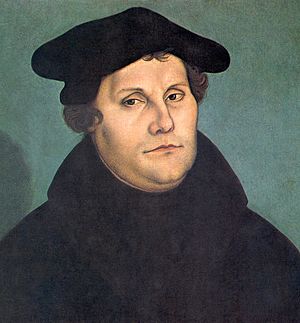Gelobet seist du, Jesu Christ, BWV 91 facts for kids
Quick facts for kids Gelobet seist du, Jesu Christ |
|
|---|---|
|
|

Martin Luther, author of the hymn, in 1533 by Lucas Cranach the Elder
|
|
| Performed | 25 December 1724: Leipzig |
| Movements | 6 |
| Vocal | SATB choir and solo |
| Instrumental |
|
Gelobet seist du, Jesu Christ (which means "Praise be to You, Jesus Christ") is a special piece of music called a church cantata by Johann Sebastian Bach. It's also known as BWV 91. Bach wrote this Christmas cantata in Leipzig in 1724. He performed it for the first time on Christmas Day, December 25, 1724. This cantata is based on a well-known hymn (a religious song) called "Gelobet seist du, Jesu Christ" from 1524, written by Martin Luther.
Contents
What is This Cantata About?
This cantata is a "chorale cantata," which means it uses a specific hymn as its main theme. For this piece, Bach used the hymn "Gelobet seist du, Jesu Christ" by Martin Luther. This hymn was very important for Christmas Day services.
The first lines of the hymn sum up the Christmas story: "Gelobet seist du, Jesu Christ, daß du Mensch geboren bist" (Praise be to You, Jesus Christ, since You were born a man). Every part of the hymn ends with the phrase Kyrieleis, which means "Lord, have mercy."
This was the first cantata Bach wrote specifically for Christmas Day in Leipzig. In his first year there (1723), he had used an older piece he wrote in Weimar.
The person who wrote the words for this cantata (we don't know who it was) used the first and last parts of Luther's hymn. They also added new sections like recitatives (a style of singing that sounds like talking) and arias (songs for a single singer).
Bach liked this cantata so much that he performed it four more times on Christmas Day. He even used parts of Luther's hymn in his famous Christmas Oratorio, which he first performed in 1734.
Instruments and Singers
This cantata has a grand and festive sound. It uses four main types of singers: soprano (high female voice), alto (lower female voice), tenor (high male voice), and bass (low male voice). Together, they form a four-part choir.
The instruments used are:
- Two horns
- Timpani (kettledrums)
- Three oboes
- Two violins
- Viola
- Basso continuo (a group of instruments, usually cello and harpsichord, that play the bass line and harmonies)
Bach later used horns in a similar way in his Christmas Oratorio.
Parts of the Cantata
This cantata has six different parts, called "movements":
- Chorale: Gelobet seist du, Jesu Christ (This is the main hymn, sung by the choir.)
- Recitative (and chorale, soprano): Der Glanz der höchsten Herrlichkeit (A mix of spoken-like singing and parts of the hymn, with a soprano soloist.)
- Aria (tenor): Gott, dem der Erden Kreis zu klein (A beautiful song for the tenor soloist.)
- Recitative (bass): O Christenheit! Wohlan (A spoken-like singing part for the bass soloist.)
- Aria (soprano, alto): Die Armut, so Gott auf sich nimmt (A duet, a song for two singers, soprano and alto.)
- Chorale: Das hat er alles uns getan (The final hymn, sung by the choir.)
How the Music Sounds
The first part of the cantata, the opening chorus, uses four "choirs" of sound: the singers, the horns, the oboes, and the strings. The music played by the instruments (called ritornellos) is also heard between the lines sung by the choir and as an accompaniment. The main hymn tune is sung by the sopranos. The lower voices (alto, tenor, bass) often echo each other or sing in chords.
In the second movement, the recitative (spoken-like singing) is mixed with parts of the hymn. The tenor's song (aria) is accompanied by the three oboes, while the strings play along with the next recitative. The last aria is a duet for soprano and alto. It contrasts ideas like "poverty" (Armut) and "abundance" (Überfluss), and "human being" (Menschlich Wesen) with "angelic splendours" (Engelsherrlichkeiten).
In the very last part of the cantata, the horns sometimes play their own special parts. They make the final "Kyrieleis" sound even more grand.
Recordings
You can listen to this cantata on these recordings:
- J. S. Bach: Das Kantatenwerk – Sacred Cantatas Vol. 5, conducted by Gustav Leonhardt, with Knabenchor Hannover, Collegium Vocale Gent, Leonhardt-Consort, and soloists Detlef Bratschke, Paul Esswood, Kurt Equiluz, Max van Egmond, from Teldec in 1979.
- J. S. Bach: Complete Cantatas Vol. 12, conducted by Ton Koopman, with Amsterdam Baroque Orchestra & Choir, and soloists Lisa Larsson, Annette Markert, Christoph Prégardien, Klaus Mertens, from Antoine Marchand in 2000.
- Bach Cantatas Vol. 14: New York, conducted by John Eliot Gardiner, with Monteverdi Choir, English Baroque Soloists, and soloists Katharine Fuge, Robin Tyson, James Gilchrist, Peter Harvey, from Soli Deo Gloria in 2000.
- J. S. Bach: Christmas Cantatas from Leipzig, conducted by Philippe Herreweghe, with Collegium Vocale Gent, and soloists Dorothee Mields, Ingeborg Danz, Mark Padmore, Peter Kooy, from Harmonia Mundi Franc in 2001.
- J. S. Bach: Cantatas Vol. 31, conducted by Masaaki Suzuki, with Bach Collegium Japan, and soloists Yukari Nonoshita, Robin Blaze, Gerd Türk, Peter Kooy, from BIS in 2004.
See also
 In Spanish: Gelobet seist du, Jesu Christ, BWV 91 para niños
In Spanish: Gelobet seist du, Jesu Christ, BWV 91 para niños

